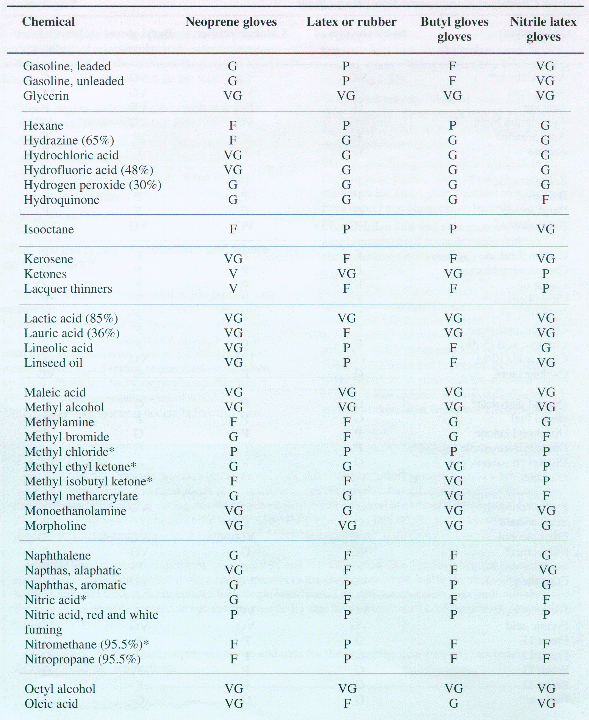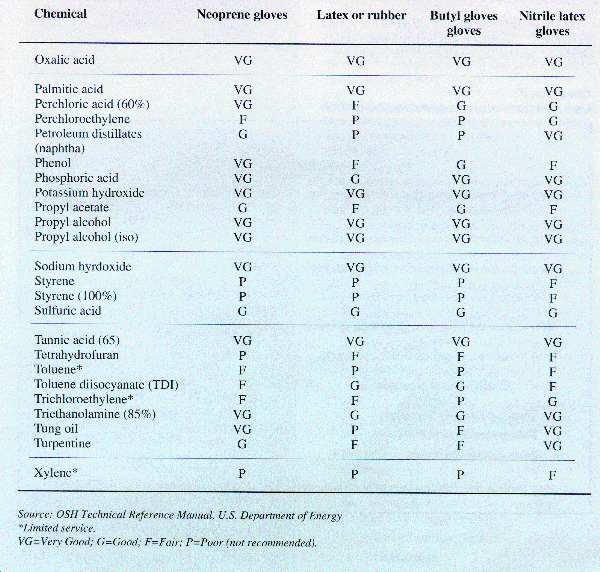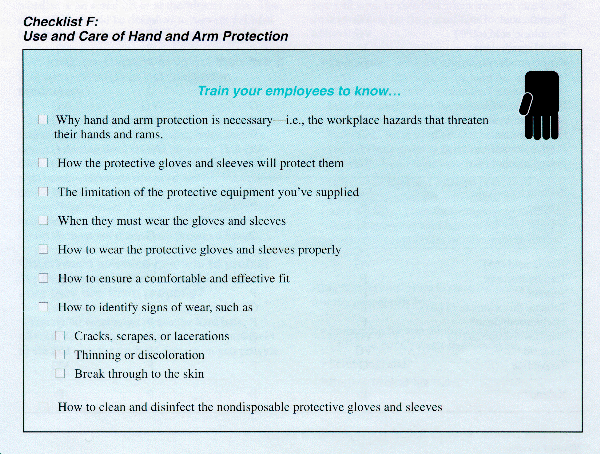
 Assessing the Need
Assessing the Need
for Personal Protective Equipment:
A Guide for Small Business Employers
Small Business Safety Management Series
U.S. Department of Labor
Occupational Safety and Health Administration
OSHA 3151
1997
When must I provide hand and arm protection?
If your workplace hazard assessment reveals that your employees risk injury to their hands and arms, and engineering and work practice controls do not eliminate the hazards, you must provide your employees with appropriate protection. The injuries you may need to guard against in your workplace include the following:
Burns
Bruises
Abrasions
Cuts
Punctures
Fractures
Amputations
Chemical exposures.
What kind of equipment is necessary to protect the hands and arms?
For many workplace operations, machine guards such as point-of-operation guards will be sufficient. For example, install a barrier that makes it impossible for employees to put their hands at the point where a table saw blade makes contact with the wood it cuts. For other hazardous operations, you may be able to institute work procedures that eliminate the risk of injury to your employees' hands or arms. When such measures fail to eliminate the hazard, however, protective gloves will be the primary means of protecting employees' hands. When the risk of injury includes the arm, protective sleeves, often attached to the gloves, may be appropriate.
Is there one kind of glove that will protect against all workplace hazards?
No. The nature of the hazard(s) and the operation to be performed will determine your selection of gloves. The variety of potential occupational hand injuries may make selecting the appropriate pair of gloves more difficult than choosing other protective equipment. Take care to choose gloves designed for the particular circumstances of your workplace.
What kinds of protective gloves are available?
Gloves made from a wide variety of materials are designed for virtually every workplace hazard. In general, however, they may be divided into four groups:
Durable work gloves made of metal mesh, leather, or canvas.
Fabric and coated fabric gloves.
Chemical and liquid resistant gloves.
Insulating rubber gloves.
Metal Mesh, Leather, or Canvas Gloves: Sturdy gloves made from metal mesh, leather, or canvas provide protection against cuts, burns, and sustained heat.
Leather gloves: Leather gloves protect against sparks, moderate heat, blows, chips, and rough objects. Welders in particular need the durability of higher-quality leather gloves.
Aluminized gloves: These gloves usually are used for welding, furnace, and foundry work because they provide reflective and insulating protection against heat. Aluminized gloves require an insert made of synthetic materials that protect against heat and cold.
Aramid fiber gloves: Aramid is a synthetic material that protects against heat and cold. Many glove manufacturers use aramid fiber to make gloves that are cut- and abrasive-resistant and wear well.
Other synthetic materials: Several manufacturers make gloves with other synthetic fabrics that offer protection against heat and cold. In addition to protection against temperature extremes, gloves made with other synthetic materials are cut- and abrasive-resistant and may withstand some diluted acids. These materials do not stand up against alkalis and solvents.
Fabric and Coated Fabric Gloves: These gloves are made of cotton or other fabric to provide varying degrees of protection.
Fabric gloves: These gloves can protect against dirt, slivers, chafing, and abrasion. These gloves do not provide sufficient protection, however, to be used with rough, sharp, or heavy materials. Adding a plastic coating to some fabric gloves strengthens them and makes them effective protection for a variety of tasks.
Coated fabric gloves: Manufacturers normally make these gloves from cotton flannel with napping on one side. By coating the unnapped side with plastic, fabric gloves are transformed into general-purpose hand protection offering slip-resistant qualities. These gloves are used for tasks ranging from handling bricks and wire rope to handling chemical containers in laboratory operations. When selecting gloves to protect against chemical exposure hazards, always check with the manufacturer (or review the manufacturer's product literature) to determine the gloves' effectiveness against the specific chemicals and conditions in the workplace.

Chemical- and Liquid-Resistant Gloves: Gloves made of rubber (latex, nitrile, or butyl), plastic, or synthetic rubber-like material such as neoprene protect workers from burns, irritation, and dermatitis caused by contact with oils, greases, solvents, and other chemicals. The use of rubber gloves also reduces the risk of exposure to blood and other potentially infectious substances. Some common gloves used for chemical protection are described below. In addition, Table 4 rates various gloves as protectors against specific chemicals and will help you select the most appropriate gloves to protect your employees.
Butyl rubber gloves: These gloves protect against nitric acid, sulfuric acid, hydrofluoric acid, red fuming nitric acid, rocket fuels, and peroxide. Highly impermeable to gases, chemicals, and water vapor, butyl rubber gloves also resist oxidation and ozone corrosion. In addition, they resist abrasion and remain flexible at low temperatures.
Natural latex or rubber gloves: The comfortable wear and pliability of latex gloves as well as their protective qualities make them a popular general-purpose glove. In addition to resisting abrasions caused by sandblasting, grinding, and polishing, these gloves protect workers' hands from most water solutions of acids, alkalis, salts, and ketones. When selecting hand protection, you should be aware that latex gloves have caused allergic reactions in some individuals and thus may not be appropriate for all of your employees. Hypoallergenic gloves, glove liners, and powderless gloves are possible alternatives for individuals who are allergic to latex gloves.
Neoprene gloves. These gloves have good pliability, finger dexterity, high density, and tear resistance which protect against hydraulic fluids, gasoline, alcohols, organic acids, and alkalis.
Nitrile rubber gloves. These sturdy gloves provide protection from chlorinated solvents such as trichloroethylene and perchloroethylene . Although intended for jobs requiring dexterity and sensitivity, nitrile gloves stand up to heavy use even after prolonged exposure to substances that cause other gloves to deteriorate. In addition, nitrile gloves resist abrasions, punctures, snags, and tears.



How do I make sure my employees properly use the equipment I have selected?
Train your employees to use the protective gloves and sleeves. Checklist F will help you teach your employees how to use and care for the equipment.
